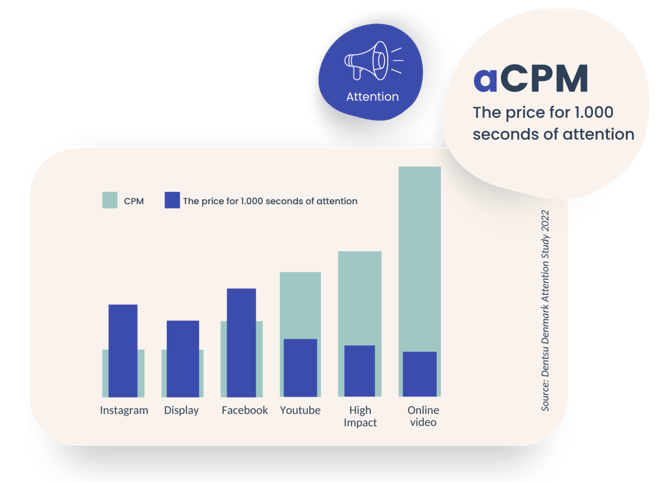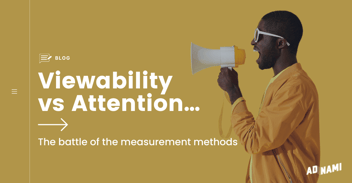Media planning with attention - deploying the metric of the moment
Welcome to another Adnami ‘how-to’ blog, in which we dissect a topic to give insight and information about the workings of a particular subject - and how to apply the learnings.
Today, we’re going to be focusing on the metric of the moment: attention. More specifically, we’re going to look at the practicalities of how agencies and advertisers can integrate this metric into their media planning and optimisation for maximum impact.
You see, while attention is getting a lot of… attention (😉) across the industry, very few outlets are actually discussing how agencies and advertisers should be using it ‘on the ground’. That’s where we come in. So, let’s take a look at how you can start working with attention, and how it will boost the performance of your ad campaigns.
Make sure you read Adnami’s Ultimate Guide to Attention.
What is attention?
For those that haven’t encountered the concept, we ought to fill you in. Put simply, attention is superseding other metrics (such as viewability) as the most accurate way of judging how, and to what degree, consumers engage with a piece of digital advertising.
Attention considers a range of behavioral triggers, including aggregated screen time, interaction rates, video completion times, and even offline sales lift stats, to provide a holistic, rounded appreciation of consumer behavior pertaining to a digital ad. Pretty cool, right? Well, not as cool as what comes next…
How much is enough attention? Introducing aCPM…
As the industry moves toward fully understanding attention, the metric has changed and evolved the way in which agencies are reporting on advertising campaigns. Adnami’s work (in collaboration with agencies and research companies e.g. Dentsu and Lumen Research) suggests the industry is transitioning to a place in which advertisers will buy seconds of attention for their ads, rather than viewable impressions, and this requires a new measurement standard.
Enter attentive CPM (or aCPM). This new metric combines attention and CPM, helping advertisers to attach a value to the amount of engagement an advertising campaign will achieve. This is how you will buy - and measure - the amount of attention your ads will achieve.
How to calculate aCPM
While this metric is currently not available on the Adnami platform, you can calculate it using Adnami attention data and your CPM data with the following formula:
CPM / eAPM * 1000

Data from Dentsu Denmark’s study ‘Attention Economy’ (2022). Results point to the effectiveness of High Impact formats and Online Video to deliver attention at a low price.
Media planning with attention
So, we now understand what attention is, and how agencies can use aCPM to attach a value to it. Great for buying attention, and great for analysing attention. So far, so good. Now let’s take a look at the practicalities of applying attention - how do you go about integrating it into your digital advertising activities?
1. Plan on creative formats
It’s a well-known fact that the biggest driver of attention is ad creative - always has been, always will be. In a privacy-first era, third-party tracking and engaging consumers using data is no longer viable, so advertisers are turning to the one thing that has always worked best in boosting engagement: amazing ad creative (and context). High impact ad formats offer brands and publishers a large canvas on which to tell their stories with colour, video, emotion and rich media. In recent research, Adnami’s desktop topscroll format achieved 3.9x the attention of a standard display ad, so considering creative from the earliest stages when designing a campaign is extremely important.
📚 Want to learn more? In this article we discuss how to design ads that stir the emotions of your audience.
2. Plan and optimise on the fly
When you know which formats are generating the most attention, you can dig deeper. It’s possible to measure attention at publisher level and based on that, you can optimise live campaigns and refine subsequent media plans. The pioneers within the attention area have introduced modified bidders for attention buying and optimisation.
3. Reach and frequency
Attention is vital, and we now know a lot about how to generate it and to measure that. But at the same time, if we don't reach the right eyeballs, and enough of them, we can’t build efficient campaigns. One solution is to plan for reach first, frequency second, and then attention third. Others might choose to go for attention first, but the principle remains: don’t abandon the basics of your campaign - the social media, the standard display advertising - but combine it and use attention metrics to go beyond.
4. Target attention
So, you have your creative in place, and you have finalised the targeting and frequency requirements of the campaign, so that you’re reaching the right kind of audience in sufficient numbers to run an efficient campaign. The final piece in the puzzle is to go after attention with the use of aCPM to choose how many attentive seconds you must buy for an efficient campaign that will have the maximum impact on the consumer. You need to be aware that different formats and placements can affect how much attention you achieve (more about that in this article), so you should adjust your bidding accordingly to achieve the results you want.
5. Better return on budget.
By analysing and modelling attentive impressions, we are able to paint a far clearer picture of the effect ads have across the customer journey, including upper- and lower-funnel KPIs. The ultimate goal of understanding attention has to be the ability to get more of it for the same budget. The more campaigns a brand runs, the more it learns; and the more efficient its media mix, the better the ROI.
So, there is your 101 guide to integrating attention into your digital marketing activities. It’s important to remember that attention needs to fit seamlessly into the wider context of your planning efforts, so if you’d like to discuss how Adnami’s high impact ad formats can help boost your campaign performance, just give us a shout and we’ll get straight back to you.
About Adnami:
Adnami's high impact advertising platform delivers astonishing ad experiences for consumers and accelerated returns for publishers and brands. Adnami’s technology first approach to high impact advertising, provides a scalable and automated solution to run attention-grabbing advertising campaigns. The company has offices in Copenhagen, London, Stockholm, Paris, Hamburg and Helsinki and works with a diverse range of clients across Europe, such as Heineken, BMW, American Express, Disney, Samsung and Amazon.
About Peter:
Peter is an experienced Marketing and Sales Professional in the advertising industry. His groundbreaking work in pioneering digital ad audience targeting using behavioral data algorithms has left an indelible mark on the field.
Today, Peter's expertise is shared through his articles on digital advertising, which place a strong emphasis on the importance of high impact formats and the development of new metrics for measuring ad attention.



